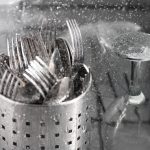The look of your dishwasher might be shiny and spotless, but that doesn’t mean there aren’t food scraps and soap film still building up. There’s a hidden mess that can slow down your drain, cause foul smells, and even shorten the life of the appliance. These issues creep up so slowly that you may not notice until you’re dealing with a sink full of dirty water or dishes that smell less than fresh.
In this blog, you’ll see how buildup starts, what you can do to stop it, and why a cleaner for dishwasher’s drain, when you use it the correct way, can save you a lot of trouble.
How Drain Buildup Starts
Every time you wash your dishes, it sends bits of food, grease, and soap through the drain. While most of it flushes away, some of it sticks to the filter, seals, and even the inner drain pipe. Over time, this residue thickens, and it traps more debris, slows the water flow, and creates a damp space where bacteria and mold thrive.
The result? Slow draining and smells that no fresh air cycle can mask. Even if your dishwasher still runs, it may not clean as well as it once did. Plates come out streaky, cups may have spots, and the air inside the appliance can turn sour after each use. Ignoring this buildup means it will spread further into the drain line.
Routine Drain Maintenance
A little care each week keeps trouble from piling up. Start by cleaning the filter. Take it out, rinse it under hot water, and scrub gently to remove grease. This step alone can keep your dishwasher from smelling musty.
Next, check the spray arms also. Food particles can clog those small holes and block water from reaching your dishes. A toothpick or a soft brush can clear them quickly.
Also, wipe the rubber seals around the door. They’re prime spots for grime. When you’re done with a cycle, leave the door slightly open for a few hours. This simple act lets moisture escape, which makes it harder for mold to grow.
Once a month, run an empty cycle with a cleaning solution. Vinegar and citric acid work for light cleaning, but they won’t reach all the hidden spots. That’s where a targeted product steps in.
Why a Cleaner for Dishwasher’s Drain Is Worth It
A cleaner for dishwasher’s drain works on the parts that cause the worst issues, the filter cavity, lower drain, and even the short stretch of pipe beyond it. These areas rarely get a deep wash during regular cycles.
The dishwasher bio-cleaner from Ahh-Some is one option that makes a big difference. It’s a thick gel that clings to residue, breaks down grease, and strips away biofilm, a slimy layer where bacteria live. You only need half a teaspoon for a full clean.
What sets it apart is its reach. It flows into tight spaces that a vinegar rinse can’t touch. It’s safe for the machine, safe for your plumbing, and even safe for septic systems. If you’ve tried basic cleaning and still deal with smells or slow drains, this is the step that clears out the gunk for good.
How to Use a Drain-Cleaning Gel
To get the best results from your drain cleaning gel, follow this process below:
- Empty the dishwasher. First, remove any dishes inside so the cleaner can work freely.
- Measure the gel. Use about ½ teaspoon and place it in the bottom of the detergent cup.
- Run a hot cycle. Heat helps the gel break down stubborn buildup.
- Pause mid-cycle (optional) to let the gel soak into deposits for a few extra minutes.
- Wipe surfaces. After the cycle, open the door and clean the filter, gasket, and spray arms.
- Run a rinse cycle. This clears any loosened debris from the system.
What to Avoid for Drain Health
Some fixes do more harm than good. Never pour chemical drain openers into a dishwasher, as they can eat away at plastic parts and seals. Skip bleach unless your manufacturer says it’s safe, and never blend or use bleach with other cleaning agents.
Enzyme-based products are great for home drains but may not be designed for dishwashers. Always check labels. Also, don’t overuse detergent pods. They may leave behind a soapy film that traps more dirt. The safest approach is to use products made for dishwashers and follow the care instructions in your manual.
Long-Term Benefits
A clean drain means every wash cycle runs at full strength. You get spotless dishes, no lingering smell, and no puddles in the bottom of the machine.
Over the years, that also means fewer repair bills. Parts last longer when they’re not coated with grease or mineral buildup. And with a regular cleaning routine, plus a deep clean from a trusted gel like the one from Ahh-Some, you keep your dishwasher running like it should. Think of it as a small step each month that saves you big headaches later.
Conclusion
Keeping a dishwasher free from clogs and smells takes steady care and the right tools. A cleaner for the dishwasher’s drain tackles the hidden buildup that regular cycles can’t wash away. As dishwashers get more advanced, they may one day warn you when a clog is forming. Until then, a quick monthly clean keeps yours fresh, fast, and ready for the next load.
FAQ
Q1. How often should I use a drain-cleaning gel?
Once a month works for most homes. If you cook a lot or notice smells sooner, clean every two weeks.
Q2. Can I run the cleaner with dishes inside?
No, you cannot. Run the cleaner empty, and the gel can reach all the drain parts without food scraps in the way.
Q3. Is it safe for septic systems?
Yes, Ahh-Some’s formula is biodegradable and septic-safe, so it won’t harm your system.
Q4. Can I use it instead of vinegar or baking soda?
Yes, for deep cleaning. Vinegar and baking soda help with light upkeep, but can’t match the reach of a gel cleaner.
Q5. What if the cycle foams or smells odd?
That’s just the cleaner breaking down buildup. Run a rinse cycle, and the scent will fade.











